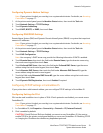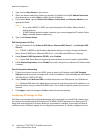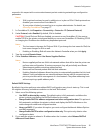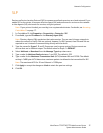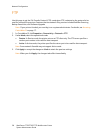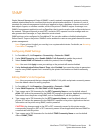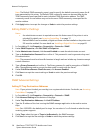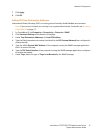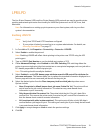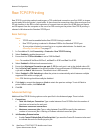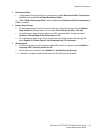Network Configuration
WorkCentre 7755/7765/7775 Multifunction Printer
System Administrator Guide
30
Note: The Default TRAP community name is used to specify the default community name for all
traps generated by this printer. The Default TRAP community name can be overridden by the
TRAP community name specified for each individual TRAP destination address. The TRAP
community name for one address may not be the same TRAP community name specified for
another address.
6. Click Apply button to accept the changes or Undo to retain the previous settings.
Editing SNMP v3 Settings
Notes:
• An administrator account is required to access this feature even if the printer is set to
unlocked. For details, see Accessing CentreWare IS on page 17.
• Before SNMPv3 can be enabled, a digital certificate must be installed on the printer and
SSL must be enabled. For more detail see Installing a Digital Certificate on page 62.
1. In CentreWare IS, click Properties > Connectivity > Protocols > SNMP.
2. Under SNMP Properties, click Edit SNMP v3 Properties.
3. Under Administrator Account, click Account Enabled to create the administrator account.
4. Type an Authentication Password then confirm it. This password is used to generate a key used
for authentication.
Note: The password must be at least 8 characters in length and can include any characters except
control characters.
5. Type a Privacy Password and confirm it. The Privacy password is used for encryption of SNMPv3
data. The passphrase used to encrypt the data needs to match with the Server.
6. Under Print Drivers/Remote Clients Account, click Account Enabled.
7. Click Save to accept the current settings or Undo to retain the previous settings.
8. Click OK.
SNMP Advanced Settings
Adding IP Trap Destination Addresses
Note: If your printer is locked, you must log in as a system administrator. For details, see Accessing
CentreWare IS on page 17.
1. In CentreWare IS, click Properties > Connectivity > Protocols > SNMP.
2. Click Advanced Settings at the bottom of the page.
3. Under Trap Destination Addresses, click Add IP Address.
4. Type the IP address of the host running the SNMP manager application to be used to receive
traps.
Note: Port 162/UDP is the default port for traps. You can select v1 or v2c based on what the trap
receiving system supports.
5. Under Traps, select the type of Traps to be Received by the SNMP manager.
6. Click Save to accept the new settings or Undo to retain the previous settings.




